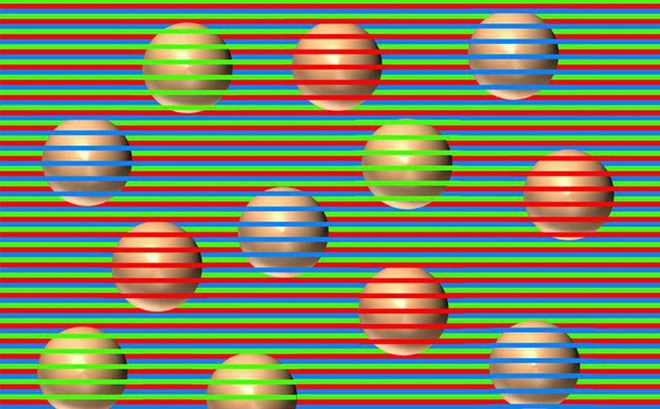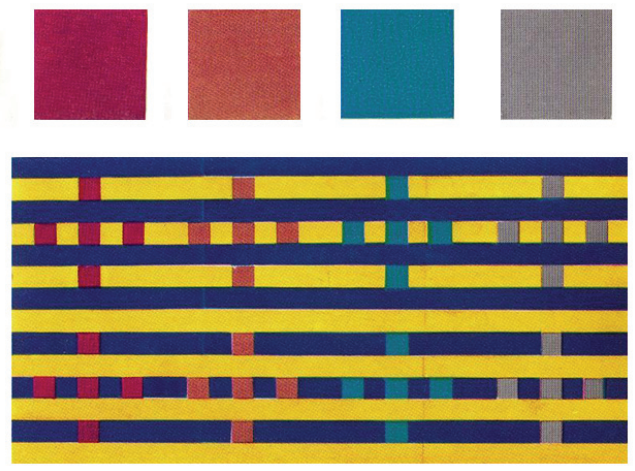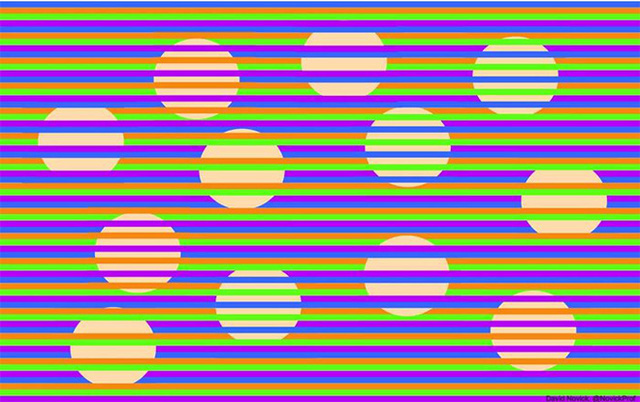Optical illusions have always fascinated and baffled the human mind, and one of the latest color illusions is no exception. You may have seen the image circulating online—twelve floating spheres that appear to be red, purple, green, and other bright hues. But here’s the twist: all of these spheres are actually the same dull beige color. Surprising, right? Let’s dive into the science behind this striking optical illusion and why your brain is tricked into seeing different colors.

The Confetti Spheres Illusion: What Are We Really Seeing?
This illusion, known as “Confetti Spheres 5,” was created by David Novick, a professor of engineering at the University of Texas at El Paso. At first glance, the spheres seem to pop out in different colors, from red to blue to green. But in reality, they are all the same beige color. The illusion is caused by the colored stripes that run across the spheres, which tricks the brain into interpreting different colors.
When you zoom out from the image, the illusion becomes even stronger, making the colored stripes seem to “bleed” into the spheres, creating the illusion that the spheres are multicolored. Zooming in, however, makes the color distortion disappear, revealing the true beige color.
Why Does the Illusion Work?
At the core of this illusion is the way our brains process color and shape. According to Novick, the illusion works because our ability to recognize shapes is far superior to our ability to perceive colors accurately. This means that the edges of the spheres are clearly defined in our brains, while the colors become blurred and blend into their surroundings.
In this specific case, the surrounding colored stripes—green, red, and blue—are responsible for steering your perception of the spheres. As a result, the spheres appear to match the colors of the stripes cutting across them, even though they are actually all the same color.
Removing the Stripes: The Illusion Disappears
Want proof that the spheres are all beige? Use Photoshop or any photo editing software to remove the colored stripes from the image. Once you do that, the illusion vanishes entirely, and all the spheres appear in their true beige color. This simple test shows how much the stripes influence your perception.
How Color Assimilation Tricks the Brain
The Confetti Spheres illusion is an example of color assimilation, where an object’s color is influenced by the colors around it. When the human brain processes visual data, it takes shortcuts to quickly make sense of what it’s seeing. In this case, the brain “assimilates” the colors of the surrounding stripes into the spheres, making the spheres seem like they match the stripe colors.

This concept of color assimilation is not new. It was first described in the 1960s by psychologist Michael White, and later expanded upon by Hans Munker in the 1970s. Their research demonstrated how the surrounding environment can change the way we perceive colors, whether through colored stripes, borders, or backgrounds.
Gray and Black Stripes: Color Illusions Still Work
Interestingly, color illusions don’t only apply to vibrant hues. Even in black-and-white images, these illusions can still trick our brains. For example, placing a gray rectangle on a white stripe will make it appear lighter, while placing it on a black stripe will make it appear darker. This shows that shades of black and gray can steer our perception just as effectively as vibrant colors.
When Does the Illusion Happen? In the Eye or the Brain?
The exact reason behind color illusions is still debated among scientists. Some believe the illusion occurs at the very start of visual processing—when light hits the retina. Others think it happens later in the brain, when data from the eyes is processed and interpreted.
Despite the debate, most agree that color perception is highly influenced by surrounding environments. The bleed effect from neighboring colors changes how we see objects. In the case of the Confetti Spheres, the colored stripes cause the brain to misread the actual beige hue of the spheres as something far more vibrant.
Why Are Spheres More Effective for This Illusion?
One curious aspect of this illusion is that it seems more intense when applied to spheres, as opposed to flat disks. David Novick and his colleague Akiyoshi Kitaoka, a professor of psychology at Ritsumeikan University in Japan, have been experimenting with different versions of this illusion to understand why. While flat versions of the illusion still work, the 3D version on spheres appears more vivid, though no one quite knows why yet.

Recreating the Illusion: Complementary Colors
Through experimentation, Novick has also discovered that choosing complementary colors—colors opposite each other on the color wheel, like red and green—can sometimes cancel out the illusion entirely. When complementary colors are used for the stripes, the spheres often appear white or gray, as the opposing colors neutralize each other. This adds yet another layer of complexity to the illusion and demonstrates the power that color choice has in manipulating our perception.
Why Optical Illusions Are Fun and Educational
Whether you’re an artist, scientist, or just someone who enjoys mind-bending visuals, optical illusions offer a fun way to explore how the brain processes information. They reveal that what we see isn’t always reality—it’s filtered through layers of cognitive interpretation. As Novick says, “it’s still fun to play with” these visual effects, especially when you consider how they challenge your assumptions about how the world works.
Conclusion: A Fun Trick of the Brain
The Confetti Spheres illusion reminds us that color is not just about what we see—it’s about how our brain interprets light and surrounding elements. Next time you see an optical illusion, take a moment to appreciate the complexity behind what seems like a simple trick. And remember, sometimes the truth is hidden in plain sight—literally, in the case of these beige spheres!
Now, go ahead and try this illusion for yourself. See if you can outsmart your brain, or better yet, impress your friends by showing them that not everything is as colorful as it seems.


